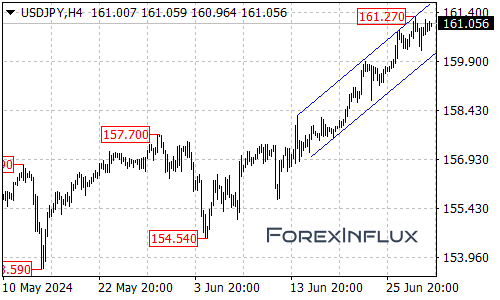The USD/JPY pair closed slightly higher at 160.81, after touching a 38-year high of 161.27 during trading. This movement comes amid a series of economic reports and market expectations that are shaping currency trends.

Inflation Data and Its Impact
Friday’s data showed that the Federal Reserve’s preferred inflation measure, the Personal Consumption Expenditures (PCE) price index, remained flat month-over-month in May and increased 2.6% year-over-year, down from 2.7% in April. This report, largely in line with expectations, confirms the gradual inflation slowdown trend seen in earlier CPI and PPI data. However, the limited scope of this slowdown meant the PCE report had minimal impact on the dollar.
Positive Economic Indicators
Other economic indicators provided support for the dollar:
- The Chicago Purchasing Managers’ Index (PMI) jumped from 35 in May to 47.4, surpassing economists’ expectations of 40.
- The University of Michigan’s June Consumer Confidence Index came in at a better-than-expected 68.2.
These positive readings offered support to the dollar in late New York trading.
Focus Shifts to Employment Data
Investors are now turning their attention to next week’s U.S. non-farm payroll report. Wall Street economists predict an increase of 195,000 jobs in June, down from 272,000 in May. Some prominent analysts suggest that the Federal Reserve is likely to maintain its current stance unless the job market begins to deteriorate.
Implications for USD/JPY
Despite remaining cautious about potential intervention from Japanese authorities, the USD/JPY pair continues to climb. This upward trend is expected to persist as long as the Federal Reserve’s rate cuts remain uncertain, maintaining the carry trade dynamic.
The pair has now broken through the 160 vigilance level without intervention from Japanese authorities. Traders are likely to continue testing higher levels cautiously.
In conclusion, while economic data presents a mixed picture, the USD/JPY pair continues to reach new heights, with market participants closely watching for any signs of Japanese intervention or shifts in Federal Reserve policy.